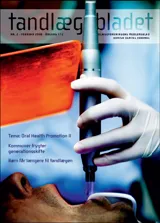Populationsstrategins återkomst. Tre svenska landstings sätt at främja barn och ungdomars orala hälsa
Strategier för att främja oral hälsa och förebygga orala sjukdomar bland barn och ungdomar bör utformas så att människor stimuleras att ta ansvar för sin hälsa. Strategierna bör så långt som möjligt grundas på evidensbaserade metoder. Det är också viktigt att sträva efter en samsyn på hälsobudskapet mellan olika kategorier vårdpersonal, pedagoger och gärna kommersiella aktörer. Författarna har studerat hur tre svenska landsting arbetar.
Strategies for oral health promotion and oral disease prevention in three counties in Sweden: During the 1960s and 1970s, when the prevalence of dental caries was high among Swedish children and adolescents, population-based strategies of prevention based on fluoride mouthrinsing in schools were common. Because caries prevalence decreased, in many Swedish counties the population strategies for preventing oral diseases were abandoned. Instead, an individual high-risk strategy was generally introduced which involved identification of individuals at risk of developing oral diseases and individual programmes of prevention. However, a large proportion of Swedish children still suffer from caries, especially when lesions in the enamel are included in the reports. The lifestyle of children and youth has changed, resulting in frequent consumption of sweet food and drinks in addition to lack of regular toothbrushing with fluoridated toothpaste. Therefore several counties in Sweden have returned to preventive strategies aimed at the whole population and now use a combination of population- and individual-risk strategies. This article describes oral health strategies in three geographic areas of Sweden: the counties of Stockholm, Uppsala and Södra Bohuslän (part of the Västra Götland region). The school is an important arena for oral health promotion as are other meeting places, especially arenas where health promoters meet persons of low socio-economic status and those from other cultures. Factors of significance for successful oral health promotion are: evidence-based methods, taking individual responsibility for one’s own health and reaching a consensus on the contents of the health message.


